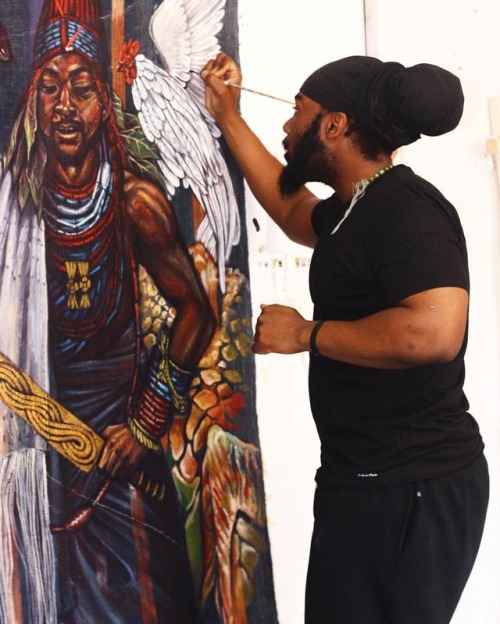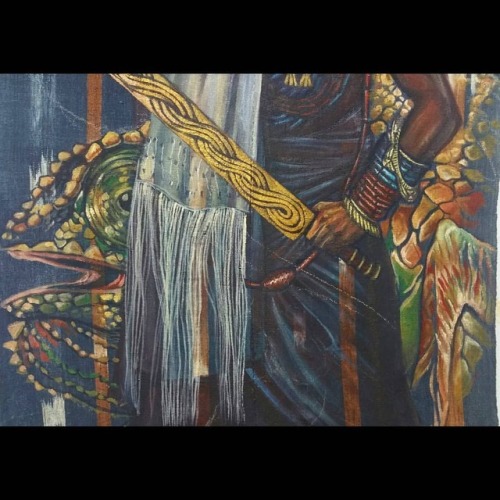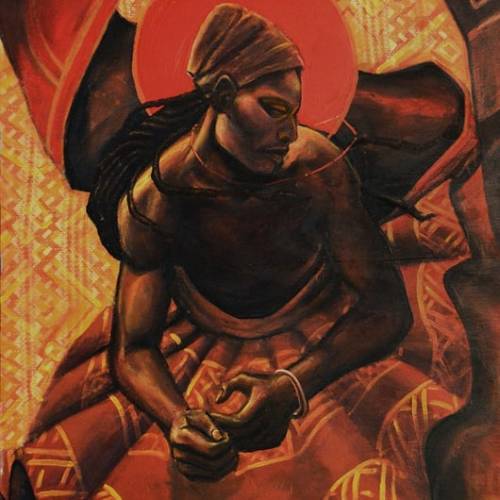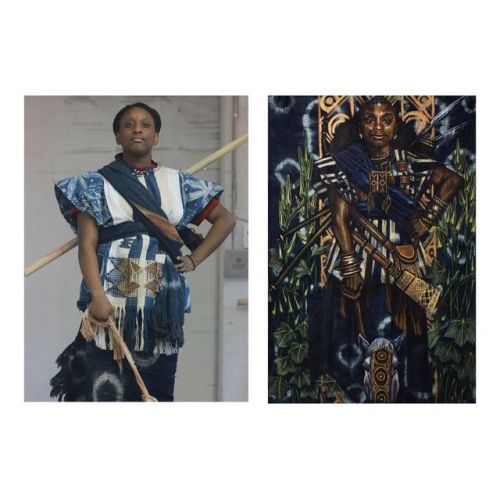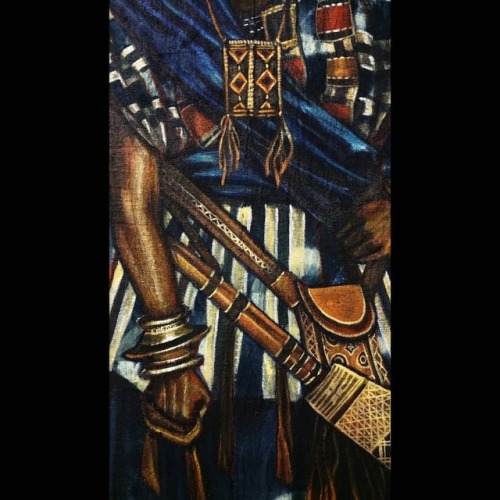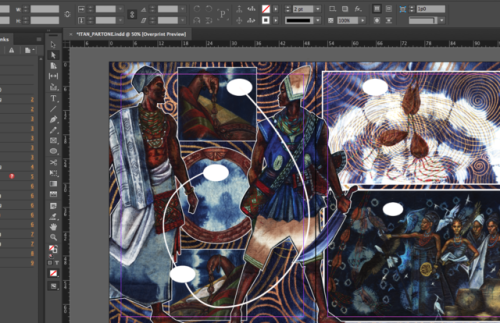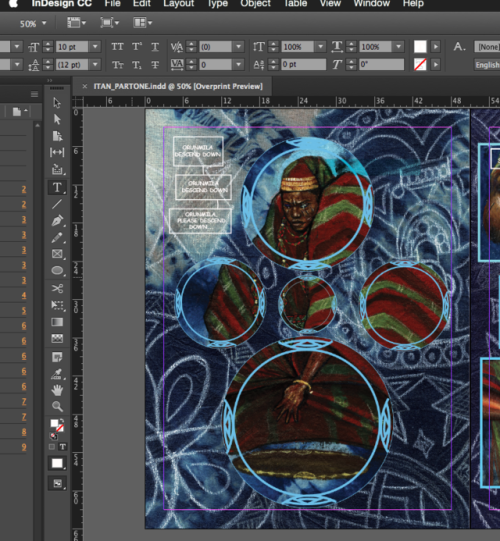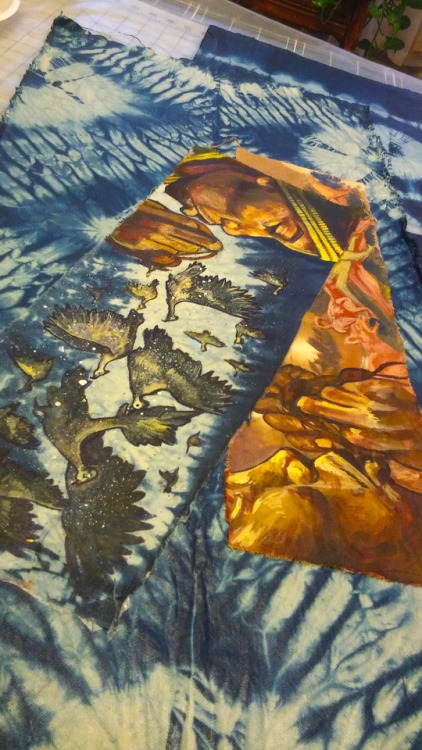#africanhistory
- Rashad Clarke as Oduduwa Acrylic on Handwoven Aso Ofi #THEFOUNDERSPROJECT
Learn more at www.itanproject.com

The finished piece. #Oduduwa complete.
Our stories are passed down from generation to generation, via word of mouth. The story of Oduduwa is no different. Follow the next phase of the journey as we help tell the story and keep the history alive. in bio. #TeachMeBlkHistory ⚫️
•
•
#precolonialafrica #artistsoninstagram #africanhistory #africaneducated #art_we_inspire #bostonart #bostonartists #bostonartscene #bostonartmakers #oduduwa #yoruba #yorubatradition #artists_insta #teachersofthegram #educational #blackhistory365 #blackhistory #teachmeblkhistory #thefoundersproject #okayafrica #naijaart #naija (at Boston, Massachusetts)
Post link
In my element. Always grateful to be in this space.
•
•
#precolonialafrica #artistsoninstagram #africanhistory #africaneducated #art_we_inspire #bostonart #bostonartists #bostonartscene #bostonartmakers #oduduwa #yoruba #yorubatradition #artists_insta #teachersofthegram #educational #blackhistory365 #blackhistory #teachmeblkhistory #thefoundersproject #okayafrica #naijaart #naija (at Boston, Massachusetts)
Post link
The chameleon who tested the stability of the earth with its delicate steps. More work on #thefoundersproject and other updates coming soon! #staytuned .
.
.
.
#thefoundersproject #painting #blackartist #supportblackart #yoruba #orisa #orisha #oduduwa #blackgodsandkings #ancestry #africanhistory .
.
.
@mocada_museum @supportblackart @printbyprint @blavity @blackart365
Post link
#flashbackfriday gonna try to tap into this energy for #thefoundersproject. I had to literally scrap this piece and start over twice. It represents #tukula the red cam wood powder, the midday sun and the prime of life in the physical world. When I Paint #Lukeni first Mwene Kongo I want tap into what I did with this painting.
.
.
.
#kongo #bakongo #kongokingdom #tukula #palomayombe #africanhistory #blackisbeautiful #painting #drawingwhileblack #supportblackart
.
.
.
@supportblackart @prinbyprint @mocada_museum @blackart365 @richardbeaversgallery @thepanafrican
Post link
Ewe oye “chieftancy leaves” and ileke"beads" #thefoundersproject more coming soon
.
.
.
#ooni #yoruba #yorubatextiles #orisha #oduduwa #omooduduwa #africanhistory #painting #drawingwhileblack #supportblackart #blackart #blackisbeautiful #wip #staytuned #thefoundersproject
.
.
.
.@mocada_museum @blackart365
@printbyprint @richardbeaversgallery @supportblackart.
Post link
“Yennenga, tree from which the Mossi people grew” Yennenga was the daughter of Madega the legendary 12th century ruler of the kingdom of Dagbon in what is now northern Ghana. A powerful warrior in her own right, Yennenga lead soldiers into battle at the age of only 14. Matchless with the bow and spear, she was a legendary horsewoman who won many battles in her father’s name. When she came of age and expressed the desire to marry, her father refused. In protest, she planted and entire crop of Okra and let it rot in the field to show how she felt her life was withering away and her time to start her own family was passing her by. Her father was unmoved, so she escaped her father’s compound disguised as a man. Upon leaving her father’s kingdom she met a young Malinke prince and elephant hunter named Riale. They fell in love and had a son Ouedraogo, who became the first Mogho Naba (king) of the Mossi empire. Though Ouedraogo was the their first king the Mossi credit Yennenga as the founder of their nation and the royal horseman of Mossiland, to this day still carry her legacy forward. Follow #thefoundersproject for more updates!
.
Photo by @stacehphotography .
#thefoundersproject #blackart #blackartist #supportblackart #theartofstephenhamilton #blackisbeautiful #painting #africanhistory #blackhistory #africantextiles #handwoven #indigo #adire #artoninstagram #drawingwhileblack #Yennenga #mossi #burkinafaso #ghana #Dagomba #portraiture #blackgirlmagic #representationmatters
Post link
“One who descended to earth on the Iron Chain” more work on #thefoundersproject coming soon!
.
.
.
#staytuned #painting #artistsoninstagram #drawingwhileblack #blackart #africanhistory #omooduduwa #yoruba #orisha #orisa #acrylicpainting #africantextiles #wip #staytuned
“Gianna Watson as Yennenga: Tree from which the Mossi nation grew” After months of preparation I am pleased to announce #thefoundersproject. The Founders Project is a multimedia installation project headed by Boston based artist and educator Stephen Hamilton. The project re-imagines Boston Public School High-School students as the legendary founders of the West and West-Central African ethnic groups, that are part of the ancestral base for the African diaspora. The pieces will incorporate painting, weaving and sculpture traditions from each of the spotlighted ethnic groups and is to be installed in a yet to be determined public space in Boston. The project will contribute to a larger syllabus on West African cultural continuity in the African Diaspora designed for High School students. Follow #thefoundersproject for more updates! #thefoundersproject #blackart #blackartist #supportblackart #theartofstephenhamilton #blackisbeautiful #painting #africanhistory #blackhistory #africantextiles #handwoven #indigo #adire #artoninstagram #drawingwhileblack #Yennenga #mossi #burkinafaso #ghana #Dagomba #portraiture #blackgirlmagic #representationmatters
Post link
#thefoundersproject is coming soon! Stay tuned!
.
.
.
#indigo #painting #artistsoninstagram #illustration #blackartist #blackart #blackisbeautiful #acrylicpainting #drawingwhileblack #africantextile #africanhistory #africanart #theartofstephenhamilton
Post link
IT’S HERE!!!! HABARI GANI YALL!! I thank everyone who helped and supported this vision! I hope you all feel the passion I put into this project.
.
.
.
#itanpart1 #osun #orisha #orisha #orunmila #ogun #osanyin #shango #ifa #babaluaye #obatala #yoruba #blackart #blackcomics #graphicnovel #adire #africanhistory .
.
@black.boy_jordan @pronzy_perez @adrianadalice @tati_dx @aundre_gray @sxnfullvibes_ @coconut_express_ @luicustoms_ @griotgrease @elplatz @the_allaroundartist_ @tamarif @wilmatic13 @normal_reggie @fadelsaidwhat @blackprincesspeach @sweetleek_ @izzyiz_boston @haikuexe @blacknerdproblems @chocolatecitycomics @blavity @printbyprint @blackart365
Here is a little insight into the composition process. Its a lot of work, but its worth it to see this project come to life. I still need help to print and distribute this work. Visit https://www.indiegogo.com/projects/itan-part-one-africa-art#/ to help bring this vision of traditional Yoruba Oral literature to life! Back the project to reserve a copy of the comic!
Post link
One of the benefits of living and working at the the Nike Centers For Art and Culture is that I get a chance to document her incredibly extensive textile collection. The collection includes Nigerian Textiles (mostly from the Yoruba kingdoms), Raffia cloths from the Kuba federation in the Democratic Republic of Congo. Malian “Bogolanfini” Mud cloths and even one beautiful example of of a Ghanaian Kente cloth. The Yoruba made textiles are by far the most extensive part of the collection and include cloths made on both the Women’s (vertical) and Men’s (horizontal, narrow strip) looms. The collection also includes a huge variety Adire (tie and dye and starch resist ) cloths executed on both handwoven and machine woven cloths. The woven textiles include antique textiles woven with hand spun cotton threads, dyed with natural dyes (Mostly indigo with some some camwood dyed warp sections). They also include “Sanyan” textiles woven with the once illustrious beige wild silk collected from the indigenous anaphe moth, as well as textiles woven with imported silks from Asia and synthetic and machine spun cotton, rayon and polyester threads from Europe, Asia and the Americas. There were Indigo robes, shirts, trousers, wrappers and hats. The textiles beauty is only surpassed by their diversity. The pieces are testaments to tradition as well as ingenuity and creativity. There are clothes that could have easily been worn in the ancient courts of Ile Ife and the Ogiso era Benin Kingdom and others that take ancient motifs and execute them with brilliant synthetic or metallic threads, sometimes sewn together with imported textiles to create beautiful and unique pieces speaking to the individuality of the weavers. I began to respect the creators not only as traditional craftsmen, but as contemporary textile artists, working from an African aesthetic tradition.
Below: Examples of textiles using hand spun, hand dyed silk (Sanyan) and cotton threads, as well as machine spun imported threads in imitation of natural dyed threads. The colors and patters used in the AsoOke (Narrow strip cloths) are similar to those created since at least the 16th century, While the striped indigo Women’s loom AsoOfi echo back to cloths made in southern Nigeria dating back the 9th century.

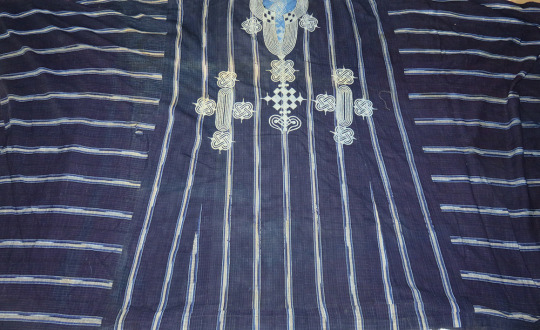

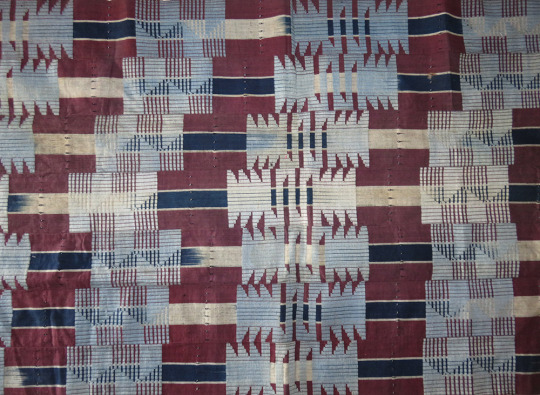

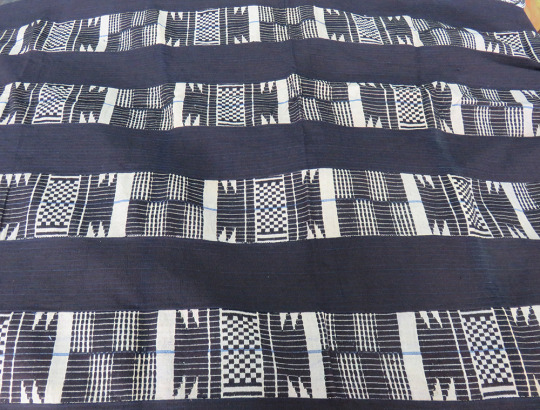

Below are examples of Adire textiles. The top two are representative of the Adire Eleko ( Cassava Starch Resist) techniques developed by Yoruba Women in the early 20th century. Below them are Examples of Adire Oniko (Tie and Dyed) on Kijipa (Hand woven cotton cloth using hand spun threads on a Women’s vertical loom). The textiles make use of the “Eleso/fruits” and “Osupa/moon” patterns. Textiles such as these were made as far back as the 11th century.
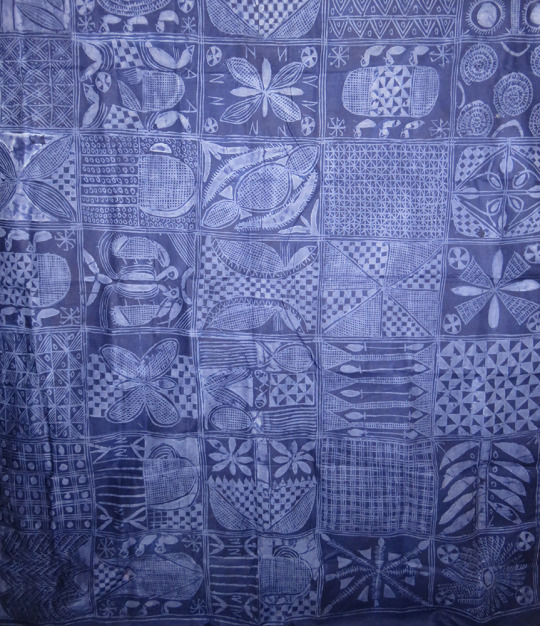


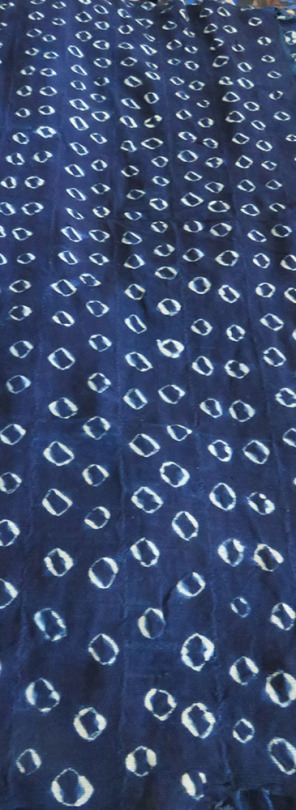

Below are some example of Chief Nike Okundaye’s extensive Raffia Textile collection.

A minimalist example of Malian Bogolanfini “Mudcloth”

A more contemporary handwoven Dashiki made using handwoven AsoOke “stripwoven” Fabric and machine embroidery. The basic style in format though is quite old.
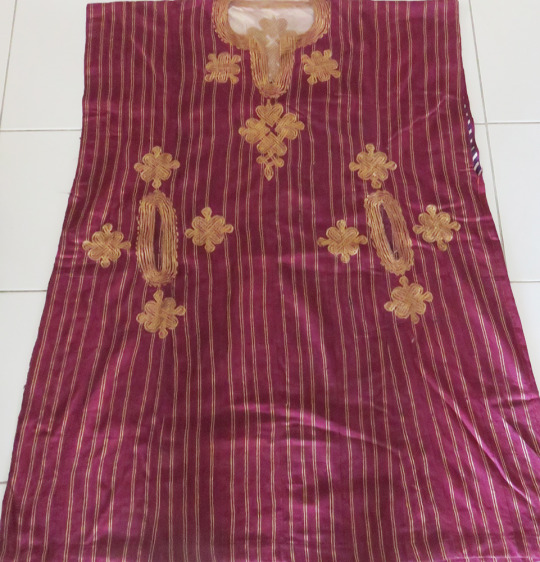
A unique cloth that incorporates machine woven Damask fabric with hand woven AsoOke, utilizing “Jawu/openwork” and metallic threads.

Being immersed in this tradition made me think about the perception African textiles in the Americas. For so many Dutch, Indian or Chinese made printed textiles have become synonymous with African cloths. These wax prints although an important part of contemporary African Identity often undercut the rich local handmade textile traditions of west and central Africa. The ancestral resist dyeing and weaving traditions that link Africa with diaspora often go unnoticed in favor of the printed textiles, as do important avenues of mutual exchange and economic development of African creative markets. The “invasion” of these foreign textiles is so absolute that they have almost completely replaced the once vibrant raffia weaving tradition of central Africa, which at one time was producing tens thousands of yards of domestic and luxury textiles. These “Wax Print” textiles were originally created by the Dutch to sell in Indonesian markets were often made to specifically imitate the Batik patterns and motifs of southeast Asia. When it was discovered that these cloths sold far better in African markets they began exporting them across the continent. Although these early 20th century Africans loved these brightly colored “new "textiles, their patterns and colorways held little to no significance to the preexisting textile traditions and at least in West African indigenous weaving and resist dyeing traditions continued to flourish and evolve alongside these newer imports. For us in the Diaspora it important to understand that our ancestors would not be able to recognize brightly colored machine made textiles that we associate with Africa now. What we call a dashiki is vastly different from the ones they wore, but also very similar to those made in West Africa today by West African weavers and tailors, who maintain these vibrant traditions. The technicolor floral and kaleidoscope patterns that dominate printed textiles would have also been alien to them, but the tie and dyed patterns that are still made and used in Nigeria, Mali and Liberia would have been strikingly familiar, as they not only predate the transatlantic slave trade, but may have been practiced by the descendants of African slaves in the Americas up until the 19th century.
Below: Pre 20th century robes: Top: Kanuri robe from the mid 19th century embroidery on imported silk. Second: Mande robe from the 17th century indigo dyed robe with tie dyed “eleso” pattern. Third: mid 19th century embroidered Dahomean robe from what is now the Republic of Benin, Strip woven fabric with embroidery. Fourth: 17th century strip woven tunic most likely from a Mande speaking region.




The indigenous textile traditions of Africa are rich and varied, and represent both continuity and change. As we in the diaspora begin to explore African textiles it is important that we understand the roots of these traditions and the fascinating ways in which these aesthetics and traditions relate to our own textile and aesthetic traditions and how we can economically support this incredible work made by black artisans.
Although I havent posted updates in a while i am still hard at work finishing Itan: part one a graphic novel based yoruba oral literature. Please visit https://www.indiegogo.com/projects/itan-part-one-africa-art/x/15991312#/. We still have long way to go to reach our goal. Please support Itan: Part one today!
Post link


